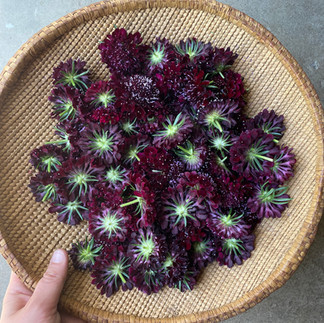Dyeing with Black Knight Scabiosa
- annacarolynmeier
- Oct 16, 2022
- 3 min read

I’ve been growing black knight scabiosa flowers (Atropax purpupea) in my garden for the last four years and every year I find new reasons to love and use this plant. It’s great for bundle dyeing and ecoprinting, and this summer I finally had the time and enough flowers to experiment with using it for immersion dyeing. The flowers are also long lasting and make great cut flowers!

A selection of fabric samples dyed with black knight scabiosa flowers and a variety of mordants and modifiers.
Black knight scabiosa are an anthocyanin rich dye, this means they are pH sensitive so the dye is easily modified with acidic or alkaline elements. I recently played around with different modifiers to create a range of colors from this dye. Because of the anthocyanin content scabiosa dye is not as colorfast as other more traditional dyestuffs. The color can change and fade over time even with the proper mordant. If you want to know more about how to use mordants and modifiers you can subscribe to my newsletter and get access to my free ebook A Guide to Natural Dyes.
These are black knight scabiosa dyed fabric samples that have been modified to alter the color. On the left the samples were modified with an alkaline element to shift the color to green. The samples in the middle were modified with an acidic solution to shift the color more toward pink. On the right the samples have been modified with iron to shift the color to a dark blue-gray.
I have found iron to be helpful in prolonging colorfastness because black knight scabiosa also contains tannins (iron and tannins have an affinity for each other, something you can learn more about in my ebook The Fundamentals of Eco-printing). I also find bundle dyeing and eco-printing concentrates the dye stuff in one area and resists fading more than immersion-dyed pieces. Black knight scabiosa also contains flavonoid compounds ( a type of yellow dye) which are more lightfast and so the leaves and stems of the plant eco-print really well, especially when combined with iron or alum mordants.
On the left iron-mordanted silk eco-printed with black knight scabiosa flowers and leaves. In the middle an alum-mordanted cotton tote bag bundle dyed with black knight scabiosa flowers and black hollyhocks. On the right alum-mordanted silk eco-printed with black knight scabiosa flowers with the dried flowers featured above.
I recently got a comment on my post about Hopi Black Dye sunflower (which is another anthocyanin rich dye) asking if there was any way to make the dye more colorfast, and was it worth it to go through all the effort to use them if there wasn’t. It’s a totally valid question and I think the same applies to black knight scabiosa and black hollyhocks as well. When I first learned about the issues of anthocyanin rich dyes I felt the same way, why go through the trouble of growing and dyeing with something only to have it fade or change once you washed it? Yet I keep growing and using these plants year after year and here’s why.. 1) They are beautiful plants that are easy to grow and give an abundance of dye material in the flower heads, stems, and leaves, they also make great cut flowers and are excellent pollinator plants. 2) they make stunning blue/purple colors which is a very hard color to achieve with natural dyes. 3) the colors last quite awhile on fabric especially if they are kept out of direct sunlight and washed infrequently or have been combined with iron. 4) It is easy to reprint or dye with the flowers after the colors start to fade. 5) The flowers dry well and can be saved for dyeing or eco-printing with in the off season.
On the left a bee collects pollen from black knight scabiosa. In the middle a basket of scabiosa flower heads freshly collected and ready to dry for later use. On the right black knight scabiosa flowers in full bloom and bud stage.
I’ve had scabiosa flower prints last for years on infrequently washed items like silk scarves (to dye your own silk scarf with my homegrown scabiosa flowers and other awesome dyestuffs check out my bundle dye kits) and even frequently washed items like shirts or underwear have lasted a year before the prints have faded significantly. This definitely isn’t a dye to use on items whose color you want to survive for generations, but it’s a great one for easy growing in the garden and for fun experiments with a more ephemeral nature. If you aren't already growing them and want to give it a go I'll have seeds up in the shop starting in January. In the meantime happy dyeing!























So interesting! I purchased some dried scabiosa flowers this year and dyed some wool and mohair yarn after an alum mordant. They went a beautiful green despite the acidity of the alum and the neutral pH of my tap water! (Close to your third from left fabric sample in the first photo. I then used the leftover dyebath for some ecoprinting (I use a paper plus fabric method wrapped and then put directly in the dyepot) , in this instance cotton, and got green but also some purpley.